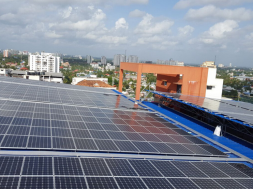
Scientists have developed a new material that can make solar cells more affordable and efficient, an advance that may allow us to better utilise the most abundant renewable energy.
The study, published in the journal Science, describes the new material called a tandem perovskite solar cell which could be used in full-sized solar panels in the near future.
“We are producing higher-efficiency, lower-cost solar cells that show great promise to help solve the world energy crisis,” said Yanfa Yan, a professor at University of Toledo in the US.
The efficiency of the new solar cell is about 23 per cent, according to the researchers including those from the US Department of Energy.
In comparison, silicon solar panels on the market today have an efficiency rating of about 18 per cent.
Perovskite — a compound material with specific crystal structure — may replace silicon, conventionally used in solar cells for converting sunlight into electrical energy.
The breakthrough discovery could prove to be a sustainable alternative to silicon-based panels.
“The meaningful work will help protect our planet for our children and future generations. We have a problem consuming most of the fossil energies right now, and our collaborative team is focused on refining our innovative way to clean up the mess,” Yan added.
“Our research is ongoing to make cheaper and more efficient solar cells that could rival and even outperform the prevailing silicon photovoltaic technology,” said Zhaoning Song, from the University of Toledo.
“Our tandem solar cells with two layers of perovskites deliver high power conversion efficiency and have the potential to bring down production costs of solar panels, which is an important advance in photovoltaics,” Song said.
Although the team has managed to improve the quality of the materials and the process to manufacture them at lower costs, they say that a lot still remains to be done.
“The material cost is low and the fabrication cost is low, but the lifetime of the material is still an unknown. We need to continue to increase efficiency and stability,” Song said.















